150 Jahre Wiener Staatsoper // 150 Years Vienna State Opera
Das Schicksal der Architekten. Mit der Premiere der Oper "Don Giovanni" von Wolfgang Amadeus Mozart wurde das Haus am Ring im Mai 1869 in Anwesenheit des Kaiserpaares feierlich eröffnet. Die beiden Architekten Eduard van der Nüll und August Sicard von Sicardsburg erlebten die Eröffnung nicht mehr.
The fate of architectsWith the premiere of the opera "Don Giovanni" by Wolfgang Amadeus Mozart, the State Opera was ceremoniously opened in May 1869 in the presence of the imperial couple The two architects Eduard van der Nüll and August Sicard von Sicardsburg did not live to see the opening.
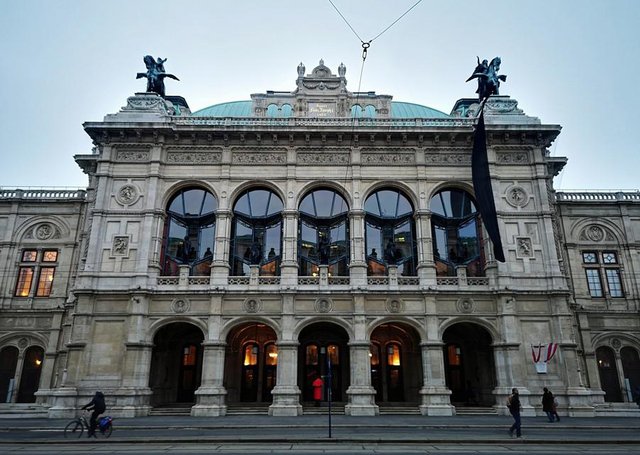
1858 war Wien eine Großbaustelle. Die alte Stadtmauer wurde abgerissen und es wurde mit dem Bau der Ringstraße begonnen. Als Erstes Haus am neuen Boulevard sollte ein monumentales Opernhaus entstehen. In einer öffentlichen Ausschreibung erhielten die befreundeten Architekten Eduard van der Nüll und August Sicard von Sicardsburg den Zuschlag. 1861 wurde mit dem Bau begonnen, der nach acht Jahren fertig gestellt war.
Vienna was a major construction site in 1858. The old city wall was demolished and construction of the Ringstraße began. The first building on the new boulevard should be a monumental opera house. The architects Eduard van der Nüll and August Sicard von Sicardsburg, who were friends won the public tender. Construction began in 1861 and was completed after eight years.
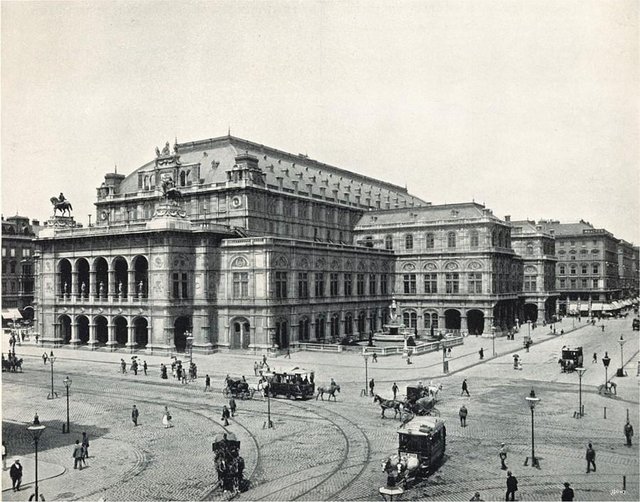
Bereits vor der Fertigstellung wurde das Operngebäude mit Hohn und Spott bedacht. Das Straßenniveau der Ringstraße wurde nachträglich um einen Meter angehoben, wodurch der Bau ohne Sockel in der Erde zu stecken schien. Als "versunkene Kiste" oder in Anspielung auf die verlorene Schlacht als "architektonisches Königgrätz" wurde das Gebäude geringschätzig tituliert. Der Baustil gab ebenso Anlass zu Spottversen: "Der Sicardsburg und van der Nüll, die haben beide keinen Styl!
Griechisch, gotisch, Renaissance, das ist denen alles ans!"
Even before its completion, the building had been ridiculed. The street level of the Ringstraße was later raised by one meter, so that the building seemed to be stuck in the ground without a pedestal. As a "sunken box" or in allusion to the lost battle as an "architectural Königgrätz", the building was disrespectfully called. The architectural style also gave rise to mocking verses: "Sicardsburg and van der Nüll, they both have no style! Greek, Gothic, Renaissance, that's all one and the same for them!"
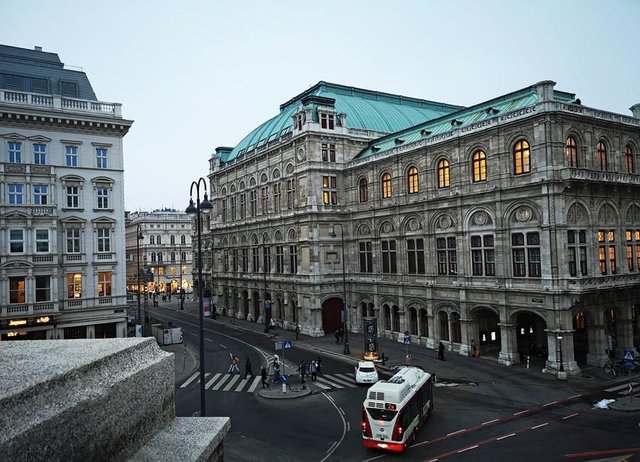
Auch der Kaiser übte öffentlich Kritik am Bau. Ob die erlittene Schmach mit ein Grund für den Freitod des unter gesundheitlichen Problemen leidenden van der Nüll war, darüber kann nur spekuliert werden. Ebenso wie über den Umstand, dass Sicardsburg kurz nach dem Suizid seines Partners verstarb, weil er den tragischen Schicksalsschlag nicht überwinden konnte. Angeblich veranlasste der Tod der beiden Architekten Kaiser Franz Joseph I. dazu, sich künftig in der Öffentlichkeit jeder persönlichen Meinung zu kulturellen Angelegenheiten zu enthalten. Seine nichtssagende Floskel "Es war sehr schön, es hat mich sehr gefreut" , mit der er fortan kulturelle Ereignisse zu kommentieren pflegte, ging in die Geschichte ein.
The emperor also publicly criticized the building.Whether the shame suffered was one of the reasons for the suicide of van der Nüll, who suffers from health problems, can only be speculated about. The same applies to the fact that Sicardsburg died shortly after his partner's suicide because he was unable to overcome the tragic fate. It is said that the death of the two architects caused Emperor Franz Joseph I to publicly abstain from his opinion on cultural matters. His meaningless phrase "It was very nice, it made me very happy", with which he commented on cultural events from then on, went down in history.
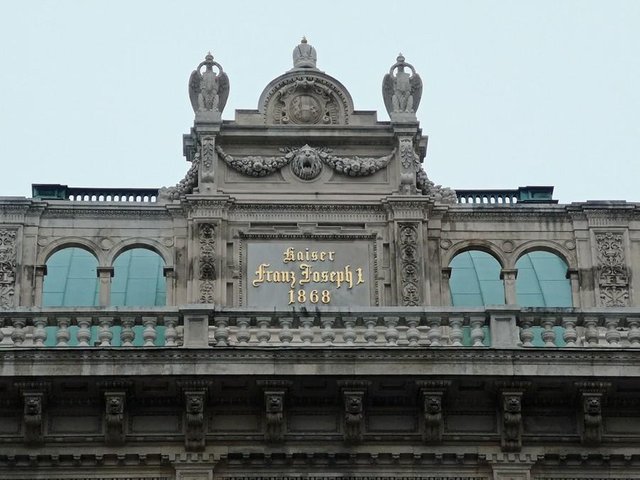
Architektur Das 19. Jahrhundert war von der Stilrichtung des Historismus geprägt. Dabei wurde auf Kunstrichtungen der Vergangenheit (Antike, Romanik, Gotik, Renaissance, Barock) zurückgegriffen. Da man vor allem das Zeitalter der Renaissance als Blütezeit der Künste ansah, wurde das Haus am Ring im Stil der Neorenaissance erbaut. Im März 1945 wurde der monumentale Bau nach Bombentreffern durch einen Brand weitgehend zerstört. Die Vorderfront des Gebäudes, die man vom Opernring aus sehen kann, blieb jedoch erhalten.
ArchitectureThe 19th century was marked by the style of historicism. Art styles of the past (antiquity, Romanesque, Gothic, Renaissance, Baroque) were thereby imitated. Since the Renaissance period was regarded as the heyday of the arts, the house on the Ring was built in Neo-Renaissance style. In March 1945 the monumental building was largely destroyed by fire after a bombardment. However, the front of the building, which can be seen from the Opernring, has been preserved.
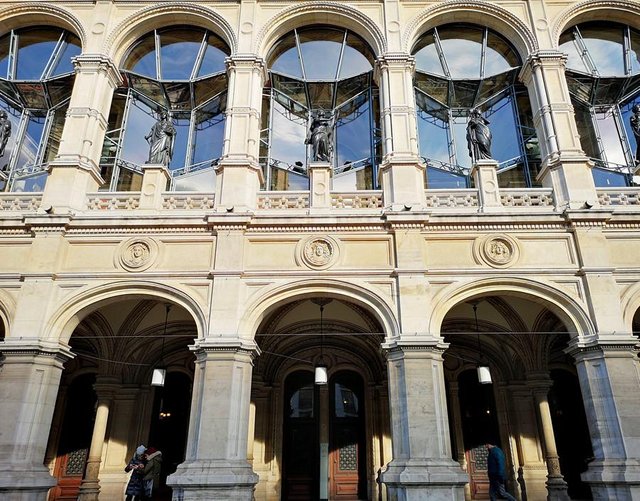
Die Fassade weist den typischen Renaissance-Bogenstil auf. Die Loggia soll Einblicke in den mit Fresken von Moritz von Schwind geschmückten Freiraum ermöglichen. Um die Fresken vor Feuchtigkeit und Frost zu schützen, wird die Loggia im Winter verglast.
The façade has the typical Renaissance arched style. The loggia provides an insight into the open space decorated with frescoes by Moritz von Schwind. To protect the frescoes from humidity and frost, the loggia is glazed in winter.
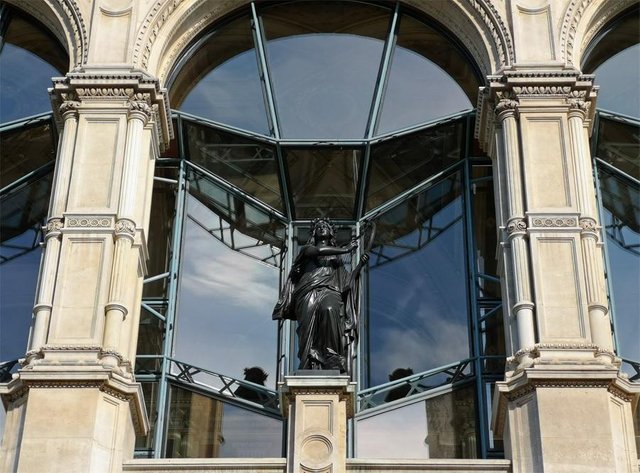
Für das Gebäude wurde ausnahmslos Naturstein verwendet, der dekorativ verziert wurde.
Natural stone, which was ornately decorated, was used without exception for the building.
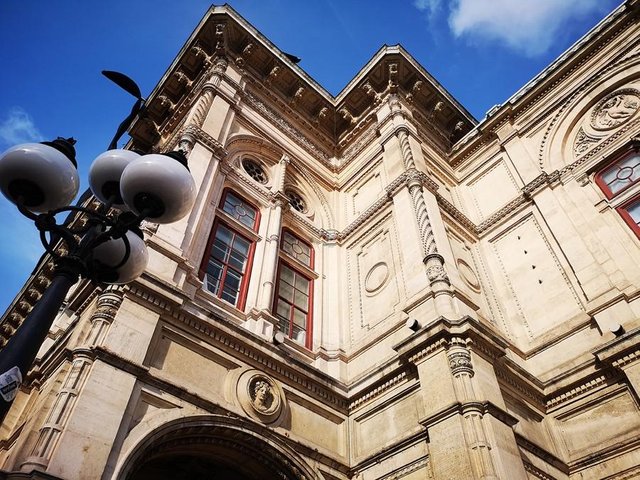
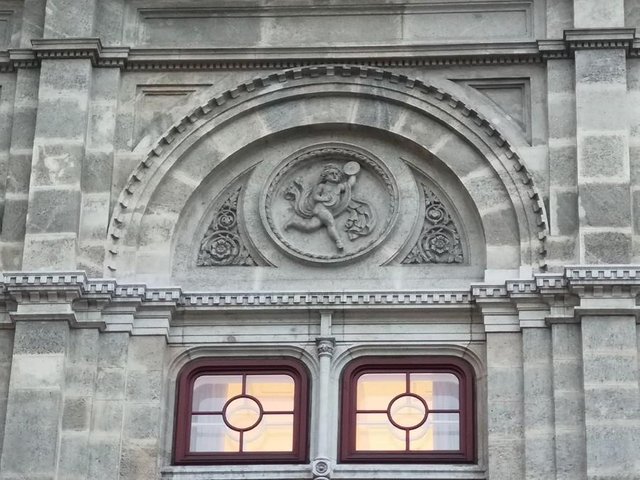
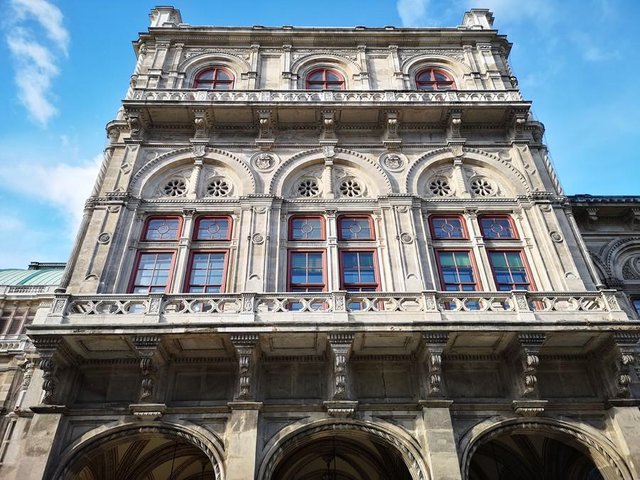
Die beiden geflügelten Pferde über der Hauptfassade wurden von Ernst Julius Hähnel geschaffen. Sie werden von der Harmonie und der Muse der Poesie (Erato) geritten.
The two winged horses above the main façade were created by Ernst Julius Hähnel. They are ridden by the harmony and muse of poetry (Erato).
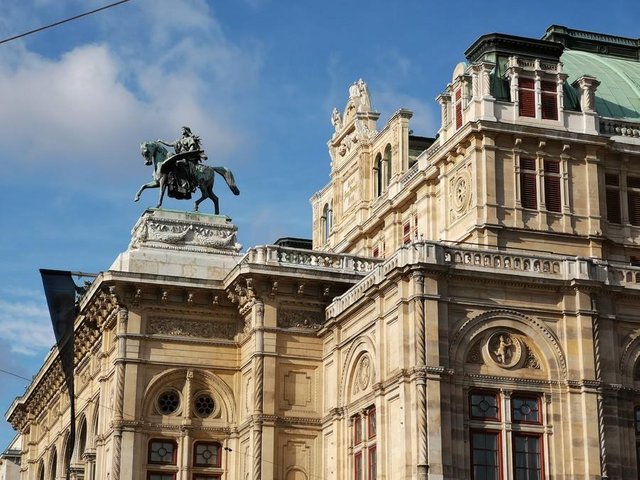
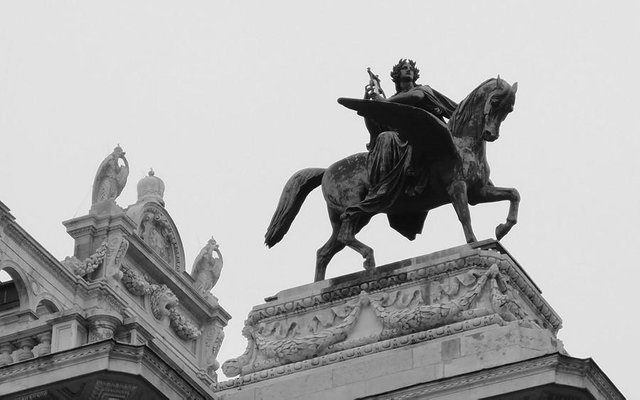
Von der Terrasse der Albertina hat man einen guten Blick auf die unterschiedlichen Dachformen des Gebäudes.
From the terrace of the Albertina one has a good view of the different roof shapes of the building.
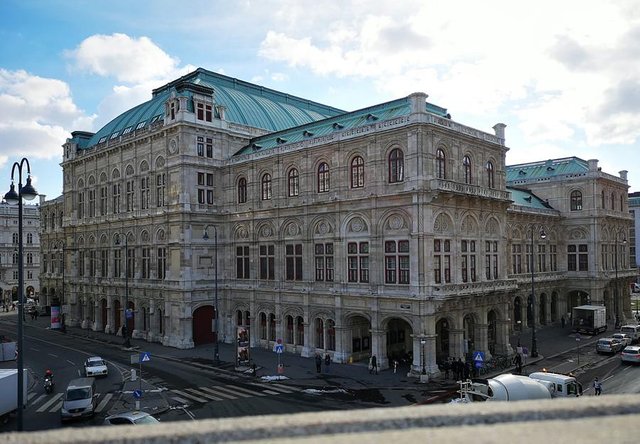
Die großen Brunnen-Skulpturen auf beiden Seiten des Hauses stammen von Hans Gasser. Auf der Seite der Kärtner Straße ist die Loreley zu sehen. Die drei Statuen darunter symbolisieren Liebe, Trauer und Rache.
The large fountain sculptures on both sides of the house were created by Hans Gasser. On the side of Kärtner Straße you can see the Loreley. The three statues below symbolise love, sorrow and revenge.
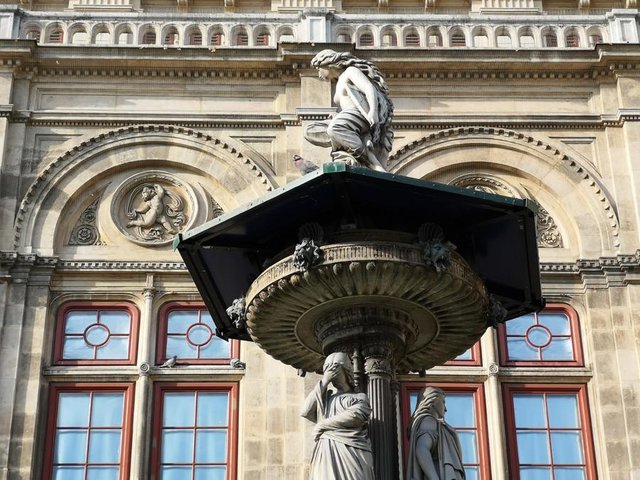
Der Brunnen auf der anderen Seite ist der Musik gewidmet. Darunter werden Tanz, Freude und Leichtsinn symbolisch dargestellt.
The fountain on the other side is dedicated to music. Below it dance, joy and levity are symbolically represented.
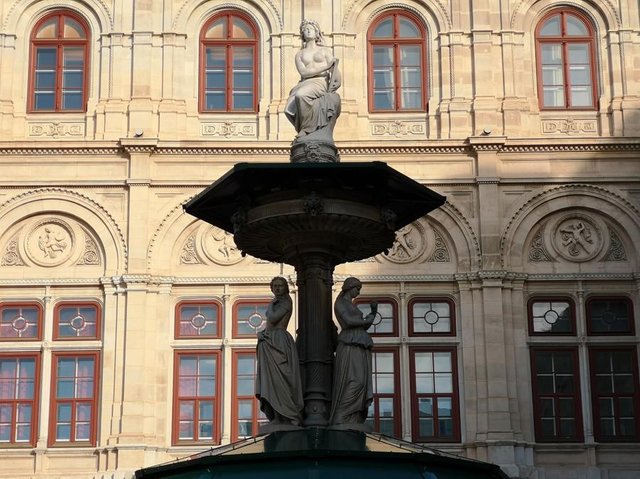
Sehr informativ und interessant! Danke!
Ich fand es spannend auch einmal hinter die Kulissen zu blicken. Danke für dein Interesse!
Eine sehr schöne Oper. Teile ich gerne weiter :-)
Vielen Dank @lichtblick! ;)
The building looks unique with beautiful architecture. Thank you for a nice story.
Thanks for stopping by! :)
Hiya, just swinging by to let you know that this post made the Honorable Mentions list in today's Travel Digest. If you enjoy steemit worldmap and the manual curation effort we're going through each day, please consider supporting what we do!
Thanks a lot for featuring my post in your daily Travel Digest!
Thanks for using eSteem!
Your post has been voted as a part of eSteem encouragement program. Keep up the good work! Install Android, iOS Mobile app or Windows, Mac, Linux Surfer app, if you haven't already!
Learn more: https://esteem.app
Join our discord: https://discord.gg/8eHupPq
Congratulations, Your Post Has Been Added To The Steemit Worldmap!
Author link: http://steemitworldmap.com?author=vieanna
Post link: http://steemitworldmap.com?post=150-jahre-wiener-staatsoper-150-years-vienna-state-opera
Want to have your post on the map too?
Hi @vieanna!
Your post was upvoted by @steem-ua, new Steem dApp, using UserAuthority for algorithmic post curation!
Your UA account score is currently 3.842 which ranks you at #4481 across all Steem accounts.
Your rank has improved 9 places in the last three days (old rank 4490).
In our last Algorithmic Curation Round, consisting of 279 contributions, your post is ranked at #140.
Evaluation of your UA score:
Feel free to join our @steem-ua Discord server
Hello @vieanna, thank you for sharing this creative work! We just stopped by to say that you've been upvoted by the @creativecrypto magazine. The Creative Crypto is all about art on the blockchain and learning from creatives like you. Looking forward to crossing paths again soon. Steem on!
Wow impressive story of deaths behind such a majestic creation ... I find it so beautiful, I liked it a lot.
It is a monumental building, worthy of being shared. Beautiful photo shots!